Bronfman, Gilbert and Philharmonic serve up slack and tired Beethoven

Yefim Bronfman performed Beethoven’s Second and Third Piano Concertos with Alan Gilbert and the New York Philharmonic Wednesday night.
There is a noticeable difference between Beethoven’s Second and Third Piano Concertos. Beethoven’s voice can certainly be heard in the Second, but stylistically the music still feels somewhat beholden to Mozart (it is, despite its number, the earliest of Beethoven’s published concerti). The third came five to ten years later, after the First Symphony was completed, and in the all-important key of C minor we hear hints of the nascent radical starting to break free.
Still, they are both decidedly early works, and making them seventy-five percent of one program—As Yefim Bronfman, Alan Gilbert, and the New York Philharmonic did on Wednesday—can result in a one-note evening.
That is especially true when the music is not met head-on with energy. Of the multiple problems that weighed on the Philharmonic’s playing, one of them was easily identifiable: Gilbert’s (and/or Bronfman’s) tempos were just too slow. Neither concerto had enough momentum in the outer movements to sustain any feeling of forward progress.
Another nagging problem is a more difficult one to fix, and has, unfortunately, been an ongoing story this season. From the very beginning of the Concerto No. 2, there was something lackadaisical about the Philharmonic’s playing. The exposition was not entirely together, and articulation was anything but crisp. This is the brighter of the two concerti, but it got off to a dreary start. There was little shape to Gilbert’s conducting (even with his strenuous emoting on the podium) and the Philharmonic’s playing was timid, coming out fuzzy when they tried to flex more muscle. The “brio” called for in the movement’s marking was conspicuously lacking.
Bronfman, usually secure and confident in his Beethoven, seemed off his game. He was consistently soft, never really taking charge of the music. He phrased intelligently, but a lot of runs, including those in the first movement cadenza (he used Beethoven’s cadenzas for both concerti) came out messy. Even the Adagio was muddled, where there should have been easy clarity.
The orchestra had a better time of it in the slow movement, playing with lyrical calm, but their tone remained too dark for the music. The same was true of the Rondo, which didn’t exhibit much bounce from anybody involved.
In the Concerto No. 3, many of the same issues resurfaced. Ensemble was iffy and articulation was flaccid, despite Gilbert’s vigorous conducting. The orchestra’s dark sound was more fitting in the stormy key of C minor, but there was no fire behind it. The violins here should be chomping at the bit, but instead they were actually dragging the tempo back.
Bronfman sounded surprisingly uncomfortable—not that Beethoven should ever feel lazy, but he felt more burdened than he should have. He righted himself in the cadenza, assaulting the big, stomping chords and diving with intensity into those Beethovenian moments wherein grace and elegance are suddenly thrown to the dogs.
Bronfman opened the Largo with calm reflection, and the orchestra matched his mood, though their tone was still off. Their hush was uneasy, as though walking on eggshells. The pianist took no pause before the finale, choosing a sudden break over a pregnant pause. His solo playing still felt sleepy in much of this movement, though the Philharmonic finally woke up, bringing a bit of sunshine into their sound.
As is so often the case, Gilbert and the Philharmonic were at their best in modern rep. Composer Sean Shepherd sheepishly referred to his Songs, which was sandwiched between the two concerti, as the “palate cleanser for the evening.” And he was right—This work was specifically commissioned for this program, to act as a short breather in the midst of all the Beethoven.
The result was a work that is entertaining and curious, but doesn’t exactly command attention. Shepherd gives titles to the piece’s seven episodes that evoke different locations. “The fair” opened with a flourish of woodwinds and a rattle from an egg shaker. Much of Shepherd’s writing is gestural, but there are melodic snatches that stick out and give us something to follow.
One particular strength of Shepherd’s is his ability to evoke atmospheres. A vibraphone with an easy, consonant ring made a dreamy setting for “The Cradle,” the strings and winds remained busy, giving a feeling of active imagination. Windy sounds, tinkling bells, and sotto voce strings made a placid ending in “The Meadow.”
The program will be repeated 7:30 p.m. Thursday and 8 p.m. Friday and Saturday. nyphil.org.







Posted Jun 04, 2015 at 10:36 pm by Stephen Essrig
Hearing this again on WQXR-and we heard it live last year. Only the last few measures of the C minor came alive. The rest, as you say, slack and tired. They are now playing the Beethoven 1st Symphony, much better, with brio.
PS Last week, I heard Susanna Malkki with Kirill Gerstein in the Brahms 1st concerto and the “Haydn” Variations, and it was fantastic. The orchestra played exceptionally well, which, of course, they are absolutely capable of doing, but only in the right hands.